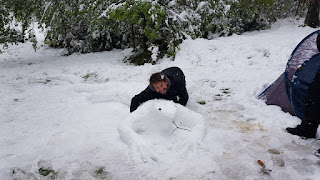New paper: life-history trade-offs of oviparity and viviparity
Congratulations to Hans and our newest paper - "Differential reproductive investment in co-occurring oviparous and viviparous common lizards (Zootoca vivipara) and implications for life-history trade-offs with viviparity". A strength of this study is that it compares oviparity and viviparity reproduction from within the same geographic area and between sister lineages, therefore minimising the effects of environment and phylogeny.
The paper is available open access from here, in Oecologia
https://rdcu.be/bAGx7
Abstract
Live-bearing reproduction (viviparity) has evolved from egg-laying (oviparity) independently many times and most abun-dantly in squamate reptiles. Studying life-history trade-offs between the two reproductive modes is an inherently difficult task, as most transitions to viviparity are evolutionarily old and/or are confounded by environmental effects. The common lizard (Zootoca vivipara) is one of very few known reproductively bimodal species, in which some populations are oviparous and others viviparous. Oviparous and viviparous populations can occur in sympatry in the same environment, making this a unique system for investigating alternative life-history trade-offs between oviparous and viviparous reproduction. We find that viviparous females exhibit larger body size, smaller clutch sizes, a larger reproductive investment, and a higher hatching success rate than oviparous females. We find that offspring size and weight from viviparous females was lower compared to offspring from oviparous females, which may reflect space constraints during pregnancy. We suggest that viviparity in common lizards is associated with increased reproductive burden for viviparous females and speculate that this promoted the evolution of larger body size to create more physical space for developing embryos. In the context of life-history trade-offs in the evolution of viviparity, we suggest that the extent of correlation between reproductive traits, or differences between reproductive modes, may also depend on the time since the transition occurred.
However the parity mode of snow lizards is still not known.
The paper is available open access from here, in Oecologia
https://rdcu.be/bAGx7
Abstract
Live-bearing reproduction (viviparity) has evolved from egg-laying (oviparity) independently many times and most abun-dantly in squamate reptiles. Studying life-history trade-offs between the two reproductive modes is an inherently difficult task, as most transitions to viviparity are evolutionarily old and/or are confounded by environmental effects. The common lizard (Zootoca vivipara) is one of very few known reproductively bimodal species, in which some populations are oviparous and others viviparous. Oviparous and viviparous populations can occur in sympatry in the same environment, making this a unique system for investigating alternative life-history trade-offs between oviparous and viviparous reproduction. We find that viviparous females exhibit larger body size, smaller clutch sizes, a larger reproductive investment, and a higher hatching success rate than oviparous females. We find that offspring size and weight from viviparous females was lower compared to offspring from oviparous females, which may reflect space constraints during pregnancy. We suggest that viviparity in common lizards is associated with increased reproductive burden for viviparous females and speculate that this promoted the evolution of larger body size to create more physical space for developing embryos. In the context of life-history trade-offs in the evolution of viviparity, we suggest that the extent of correlation between reproductive traits, or differences between reproductive modes, may also depend on the time since the transition occurred.
However the parity mode of snow lizards is still not known.



